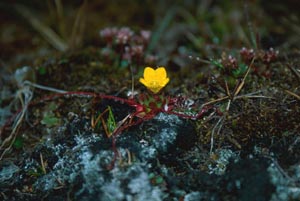Søraust-Svalbard's vegetation
By Øystein Overrein (ed.), Jørn Henriksen, Bjørn Fossli Johansen, Kristin Prestvold
 Polar stoloniferous saxifrage (Saxifraga platysepala) – a beautiful plant that occurs by Kapp Lee, as well as in other places. (Image: Marie Lier) Polar stoloniferous saxifrage (Saxifraga platysepala) – a beautiful plant that occurs by Kapp Lee, as well as in other places. (Image: Marie Lier)
The eastern areas of the islands of Barentsøya and Edgeøya have vegetation that belongs to the Arctic polar desert zone. Much of the high-lying areas are open and dominated by the Svalbard poppy (Papaver dahlianum). The vegetation communities in lower-lying areas in the east have been fertilized by reindeer droppings through thousands of years and are characterized by disconnected moss tundra. In Rosenbergdalen in the north-east part of Edgeøya, 60% of the area is covered by vegetation. About 25% of Barentsøya and Edgeøya are covered by vegetation.
The climate is more favourable in the west, towards Storfjorden, with types of vegetation that belong to the northern Arctic tundra zone. On Barentsøya, the vegetation is dominated by alpine wood-rush (Luzula arctica). Much of this type of vegetation can also be found on Edgeøya. South of Diskobukta and by Russebukta the vegetation is different; a grass called alpine hair-grass (Deschampsia alpina) is abundant.
The Nordaust Nature Reserve and the Søraust Nature Reserve have 11 red-listed vascular plants. The latter have 103 vascular plants.
|